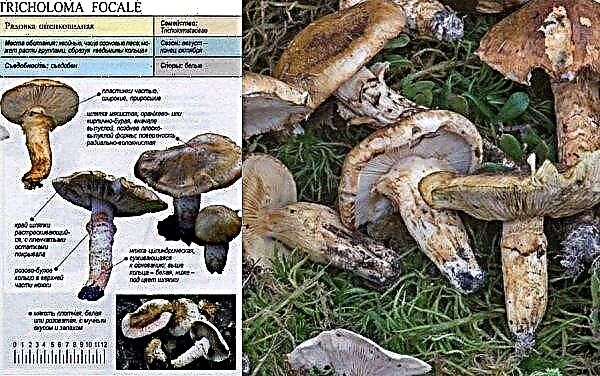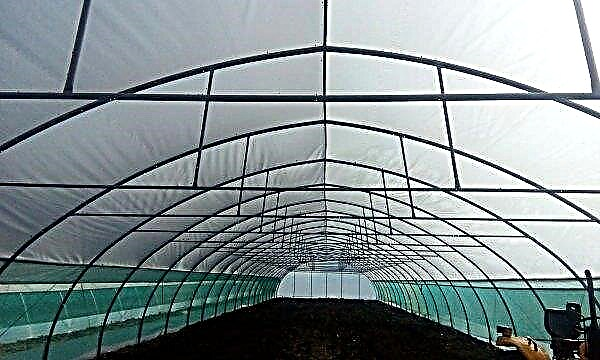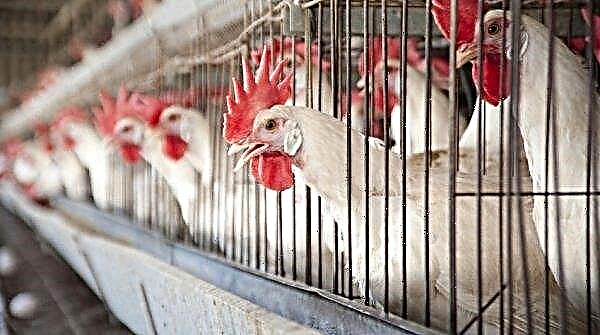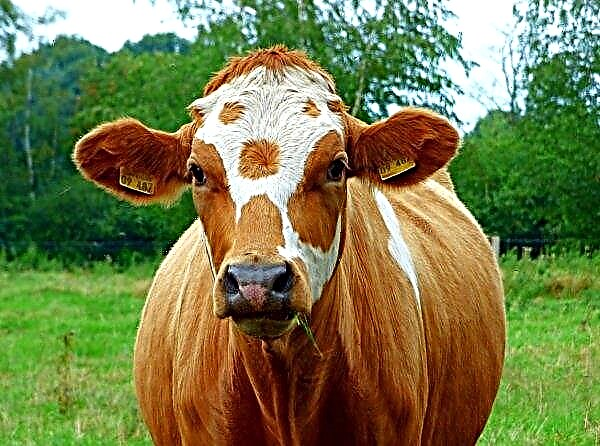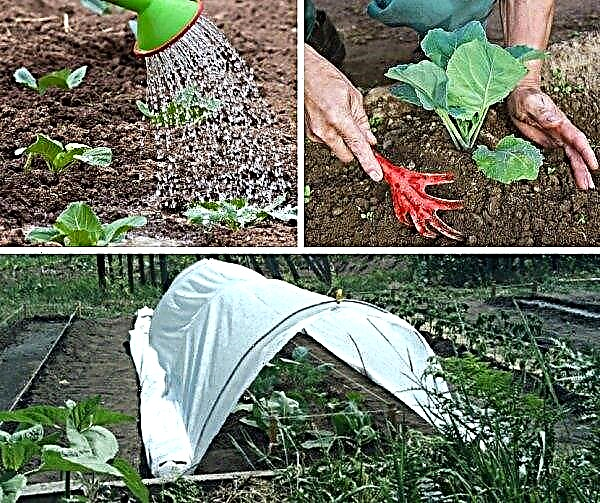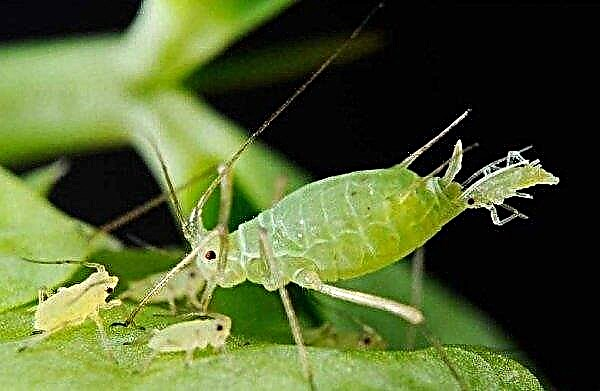Honey bees began to be used by people to get honey and other bee products long before the beginning of our era. In the article, we consider information about the honey bee - its description, the work of organs, the composition of the nest, the characteristics of reproduction and swarming, the main characteristics of popular breeds and more.
Did you know? All breeds of honey bees are indicators of biomonitoring of the ecological environment. By their physiological indicators and the presence of harmful substances in the bodies of the inhabitants of the hive and beekeeping products, you can monitor the state of the area’s ecology.
Description and characteristics of honey bees
The body of this insect from the bee family is divided into three parts - the head, chest and abdomen. The abdomen of female bees is divided into 6 joints, and in males it is divided into 7. The animal rests on the exoskeleton surrounding it - the cuticle, which combines all the body parts into a single whole. The body on top has hairs that help to feel, and also protect against dirt from the external environment. In the head of the insect there is an internal skeleton called the tentorium, consisting of dense chitin beams.
At the top of the head there is a pair of antennae, consisting of 11 joints of the same length, and for males (drones) - of 12. The bees have a complex oral apparatus. The mouth in front is covered by a narrow strip of chitin - the upper lip. The lower lip and a pair of lower jaws (maxilla) make up the proboscis, which is visible only during absorption. At its end is a small spoon collecting nectar, inaccessible to the suction tube. On the sides of the mouth are the upper jaws (mandibles, or mandibles), which also perform the functions of the hands. These insects go through a full development cycle, and this type involves four stages - eggs, larvae, pupae, and adult insects. According to scientific classification, insects belong to the animal kingdom. So, honey bees living in the hives belong to domestic animals, but do not play such a role in human life as, for example, cats and dogs, and are no different from wild ones.
On the sides of the mouth are the upper jaws (mandibles, or mandibles), which also perform the functions of the hands. These insects go through a full development cycle, and this type involves four stages - eggs, larvae, pupae, and adult insects. According to scientific classification, insects belong to the animal kingdom. So, honey bees living in the hives belong to domestic animals, but do not play such a role in human life as, for example, cats and dogs, and are no different from wild ones.
There are 30 breeds of honey bee species that differ in color and size, behavior and resistance to different climatic conditions. Typically, the varieties of this insect have a gray color or characteristic yellow stripes.
Did you know? The birthplace of the honey bee is Asia, where they appeared about 300 million years ago and settled in Eurasia and Africa. They were brought to Australia and the American continent by Europeans.
The work of the body and individual organs
Consider the features of the honey bee.
Digestive system
Three sections are involved in the digestion of food. The first consists of a pharynx, esophagus and honey goiter. This goiter expands 3-4 times when nectar or honey enters and through its muscles can squeeze nectar (honey) out through the proboscis. The main process of digestion occurs in the middle intestine (second section).
After it, everything goes to the third section (small and large intestine). The large (rectum) intestine has considerable capacity and accumulates undigested food, which is stored for a long time due to the enzyme catalase, which does not allow it to decompose. Emptying for the winter stops and the first time occurs during the first departure in the spring. Bee litter is not used by humans, not only because it is problematic to collect, but also because it may contain infectious agents. Sometimes litter mistakenly call such beekeeping products as morbidity and propolis.
Emptying for the winter stops and the first time occurs during the first departure in the spring. Bee litter is not used by humans, not only because it is problematic to collect, but also because it may contain infectious agents. Sometimes litter mistakenly call such beekeeping products as morbidity and propolis.
Respiratory system
When inhaling, air enters the holes in the cuticle (spiracles) on the chest (3 pairs) and abdomen (6 pairs). They have hairs that clean the incoming air from small particles of dust. From the spiracles, air goes to the paired bags present in the head, chest and abdomen. Of these, through trachea, he reaches all the organs of the body.
Organs of movement
Honey bees have two pairs of wings - the anterior (much larger) and hind: they are presented in the form of thin transparent plates with veins. In flight, both pairs of wings form one plane, connecting to each other through hooks (hamulus) of 17–28 pieces located in front of the hind wings. When they land, they separate and the bee wings fold.
Did you know? Honey bees can reach speeds of up to 65 km / h (light) and fly away from their homes up to 4 km away. After a bribe, their speed decreases to 20-30 km / h.
Sensory organs
A bee has mosaic vision. The composition of the complex eyes of females may include 3-4 thousand eyes (in the uterus) or 4-5 thousand eyes (in working bees). In males, their number reaches 7–10 thousand. Three pairs of simple eyes are located on the little head. Honey bees see yellow and blue, but do not notice red. They can see ultraviolet and polarized light, which helps them navigate if the sun hides behind the clouds. An interesting fact is that the bees do not have hearing organs in the usual sense, but they hear well with antennae and legs. The antennae also have receptors by which the animal can determine humidity, temperature, and carbon dioxide level. Antennae are still olfactory organs. Touch occurs through hairs located on the surface of the body. Taste buds are located in the throat, on the antennae, legs.
An interesting fact is that the bees do not have hearing organs in the usual sense, but they hear well with antennae and legs. The antennae also have receptors by which the animal can determine humidity, temperature, and carbon dioxide level. Antennae are still olfactory organs. Touch occurs through hairs located on the surface of the body. Taste buds are located in the throat, on the antennae, legs.
Poison glands
On the back of the abdomen are two poisonous glands with a capacity for poison and a sting 2 mm long and a thickness of only 0.1 mm. The sting is in notches, as a result of which it gets stuck in the skin of a bee bitten and causes the latter to die. When a bite is injected 0.3-0.8 mm of bee venom. It is colorless and has a bitter taste and multi-component composition.
Important! The lethal dose for an adult is 2 g. These are 500–1000 bee stings.
Life Cycle and Reproduction
Bee colonies are community colonies in which each member carries out his work. Different members of the bee family vary in life expectancy, depending on some factors.
Uterus
This is the only full-fledged female in the nest capable of reproduction. Its genitals are superbly developed - in the ovaries, there are about 180-200 egg tubes in which the nucleation of eggs occurs. The ovaries have a pair of oviducts, which are connected in one connected by the vas deferens with the vas deferens. After mating with males (drones), their sperm enters and is stored in the receptacle for the entire life of the uterus. Mating usually occurs on the 7-10th day of uterine life.
At first, starting from 3-5 days from birth, she makes familiarization sorties. Then, choosing a fine day, she makes breeding flights with drones and mates with several males. After 2-3 days, she lays eggs 1.5–1.6 mm in size in cells of cells prepared by other bees. During this period, the working bees provide her with intensive nutrition and regulate the laying of eggs. Drones emerge from unfertilized eggs, and females from fertilized eggs. After 3 days, larvae emerge from the eggs, which the first 3 days the worker bees feed with milk, and the next 3 days - a mixture of honey and pepper. Then the cells are sealed with larvae, where they spin a cocoon for a day, having previously emptied them in the corner of the cell.
Drones emerge from unfertilized eggs, and females from fertilized eggs. After 3 days, larvae emerge from the eggs, which the first 3 days the worker bees feed with milk, and the next 3 days - a mixture of honey and pepper. Then the cells are sealed with larvae, where they spin a cocoon for a day, having previously emptied them in the corner of the cell.
After 12 days, the larva transforms into a full-fledged bee, after which the insect gnaws its way to freedom. In total, from laying the eggs to the birth of the formed individual, 21 days pass, but the uterus forms faster - in 16 days. If necessary, bees can bring a new uterus out of any larva of 1- or 2-day old. The uterus has larger dimensions (18–25 mm) and shortish wings in comparison with the body, as well as a slightly shorter proboscis (3.5 mm).
Important! The uterus can lay drone eggs due to old age or due to damage to the oviduct. This situation leads to the death of the bee family, so beekeepers get rid of the drone uterus.
It is most prolific in the first 2 years of life, and then egg production drops. The uterus itself lives on average up to 5 years, but can reach the age of 8 years. Reproduction of the uterus can be carried out in two forms - natural (swarming) and artificial, for which different methods are used (layering, dividing families and raids on the uterus).
Working bees
The basis of any bee colony is made up of working bees. In large families, they can be up to 20-30 thousand individuals in the winter and up to 80 thousand copies in the summer. These are females with underdeveloped reproductive organs. Worker bees take care of the offspring, look after the uterus, build, clean and guard the nest, prepare the cells of the honeycombs and seal them, bring prey.
Young (beehive) bees work in the hive, not strong enough to fly for a bribe. Individuals aged 15–18 days that have grown up and gain strength begin to engage in active collection of flower pollen and nectar, water and glue. Such individuals are called flying. The average life span of a working bee during a bribe period is 30–40 days. However, if the life cycle occurred in the cold season, then these terms are extended, since in winter the work time in the hive is less. How much a honey bee lives is affected by the intensity of its work. The more she works, the shorter her life cycle. Bees that appeared in the fall or in the absence of a brood can live up to 12 months.
However, if the life cycle occurred in the cold season, then these terms are extended, since in winter the work time in the hive is less. How much a honey bee lives is affected by the intensity of its work. The more she works, the shorter her life cycle. Bees that appeared in the fall or in the absence of a brood can live up to 12 months.
Drones
Males exist for insemination of the uterus. They are slightly larger than working bees, but they do not have a sting, and the proboscis is shorter, which makes them incapable of working. Drones have a length of 15-17 mm and a body weight of 0.2 g. They are formed into an adult from an egg in 24 days. Sexual maturity is achieved by males not earlier than 12 days of life. In warm time, they mate with the uterus, after which they die, leaving part of their genitals in it.
Did you know? African bee, or a killer bee, which is highly aggressive, also refers to honey bees. She was taken out by chance during experiments in Brazil in 1956.
Drones circling the uterus to fertilize it distract the attention of birds feeding on bees. Sometimes drones change their family for another, but for the winter they are expelled from any nest, and they die. In general, the life expectancy of males is highly dependent on the presence of the uterus in the family and its readiness for mating. Usually their life expectancy is from 2 weeks to 6 months.
Nest structure
The base of the bee nest is made up of double-sided honeycombs 24–25 mm thick with hexagonal cells. Between them, a distance of 10-12 mm is left for movement.
The cells themselves are polished with propolis and are divided into the following types:
- Bees. In such honeycombs, worker bees are brought out and food for them is added (honey and bee bread). On average, their width is 5.42 mm, and the depth is 11-12 mm.
- Drone. In them, the uterus lays unfertilized eggs for hatching males or storing honey. The average width of such a cell is 6.5 mm.
- Mother liquors. As a rule, they are built separately from the honeycombs, but adjoin them.
- Transitional. They have an irregular shape and are in transition from bee to drone honeycombs, along the edges of the frames or where patching of the injuries occurred.
- Honey. Located at the top of the honeycomb and have an elongated shape with a slope upward 13 ° to avoid leakage of honey.
Did you know? Russian law does not regulate the ownership of the swarm. In ancient Rome, a bee swarm was the property of the owner as long as he was chasing him. If the owner did not do this, then swarming bees could be taken by anyone.
Swarming and spreading in nature
The uterus produces a special uterine substance for bees, which is transmitted to them. When there are a lot of residents in the nest, due to the intensive laying of eggs by the uterus, it is not enough, and the insects become restless. First, they begin to prepare for swarming - they make a cell for a new uterus, and they begin to restrict the old one in reproduction, stop building bee honeycombs, complete or incomplete cessation of the collection of pollen and nectar. Then, when the queen cells are sealed, a natural separation occurs when the old uterus, accompanied by a part of the bees and drones, flies away to build a new nest in a suitable place. First, the uterus, along with its escort, is grafted onto a tree branch and can stay there from several hours to several days until scout bees arrive, finding a place for a new nest - a hollow, cave or crevice. Such swarming can be repeated, and the next time the swarm is led by a young uterus.
Then, when the queen cells are sealed, a natural separation occurs when the old uterus, accompanied by a part of the bees and drones, flies away to build a new nest in a suitable place. First, the uterus, along with its escort, is grafted onto a tree branch and can stay there from several hours to several days until scout bees arrive, finding a place for a new nest - a hollow, cave or crevice. Such swarming can be repeated, and the next time the swarm is led by a young uterus.
Did you know? Worker bees need to visit 19 million flowers to collect 1 kg of honey. Each bee can collect nectar from 7 thousand flowers per day.
Common breeds
Consider the characteristics of the most famous European breeds for beekeeping:
- Gray Mountain Caucasian. It has a gray-silver color, weak swarm, not aggressive, but it protects the hive well. It has excellent performance, collects a lot of honey even from bad honey plants. She does not have the best resistance to disease and frost, representatives can steal honey.

- Ukrainian steppe. They winter well, are very hardworking and have highly productive queens. They are prone to swarming, moderately aggressive, poorly accept foreign queens. They have a gray color, but individuals with three yellow stripes are found.

- Carpathian (Carpathian). It has a peaceful disposition, high efficiency, tolerates winters and is resistant to disease. It does not have a tendency to swarm. It collects enough honey even from bad honey plants and easily switches from one type of plant to another. It has a gray color.

- Krainskaya (carnica). Peaceful, not swarming, productive. It tolerates cold and heat. It is painted in gray-silver tones.

- Buckfast. A hybrid based on an Italian bee. The breed is peaceful, productive, resistant to disease, not prone to swarming, characterized by faster development. It has a yellow-brown color.

- Italian Loving and highly productive breed with medium loyalty. She has the most egg-laying uterus. It is better to breed in the southern climate, because the breed does not winter well.

- Central Russian. It winters well, has good immunity, endurance and performance. The uterus is characterized by high egg production. The breed is prone to swarming. Such a bee prefers to collect from one type of plant, but if necessary, can collect nectar from other flowers. It does not steal honey, but is aggressive towards the beekeeper. It has a dark gray color and a larger size.

Maintenance and care
In order to successfully breed bees to get beekeeping products, you need to properly install the hives and provide the insects with proper care.
Beehive Location
To choose the right place for an apiary, you must adhere to the following rules:
- The place should be quiet and protected from gusts of wind, as well as direct sunlight.
- Evidence should be placed with a slope to the south, so that there is enough lighting.
- The apiary is located away from large bodies of water, highways, farms, industrial facilities.
- Around the apiary should be enough vegetation that gives nectar, with different flowering times. If there is no such place, then the evidence will have to be moved to blooming places.
- The apiary and the area around it - to collect nectar, this is a radius of 2-3 km, should be without stable foci of disease.
Did you know? It is noted that the Central Russian breed of honey bees emits the most beneficial substances in honey.
Arrangement
Evidence can be acquired, or can be made independently from a tree of soft breeds. An important point is the coating of bee houses with a special varnish paint, which will protect well from moisture and enable the bee to quickly find its home. To do this, you need to choose yellow, blue and green.
To service the apiary, you must purchase the following tools:
- overalls;
- front mesh;
- smoker
- the wax that is inserted into the frame - without it, you will get many defective cells;
- special knife;
- caps and cells;
- spur;
- chisel;
- feeders and sugar for syrup (needed for feeding);
- swarm - a box for catching bees;
- rink.

Care depending on the season
Care for bees and apiary largely depends on seasonality:
- In the spring. As soon as the street gets warm (+ 8 ° C), the evidence is transferred to fresh air and transplanted families with whole frames into new houses. At the same time, a honey-pergovy frame is printed. Honey in evidence should be at least 8 kg. Old hives are repaired, cleaned and disinfected. If the apiary is located in a place where no bribes are observed in the spring, then after 30 days it is necessary to add pergi and honey. Care should be taken to warm the evidence (cover the joints, cover).
- In summer. They control the swarming process and take only the first swarm from the hive, collecting it using a swarm and a scoop. Individuals who have not expressed a desire to move into a swarm are driven there by smoke, blowing it in the right direction. If necessary, unnecessary queens are removed from the swarm or planted if it cannot be caught. The filled shops are cleaned and put back so that the bees drain the frames. At the end of August, stores should be removed.
- In the fall. On the eve of wintering, it is necessary to check the quality and quantity of honey for the presence of paddy. To do this, take samples and conduct laboratory tests or try to determine on their own. If there is a paddy, honey is removed from the honeycombs and stored for use as feed in the spring. In place of the frame, put a frame with good honey or sushi. You can use sugar syrup as top dressing. In autumn, you should make the replacement of old queens with new ones. They organize nests for the winter - on honey, partly on honey or on sugar syrup enriched with vitamins. Insulate evidence, carry out treatment for varroatosis and prepare them for wintering.
- In the winter. Keep the temperature in the place of wintering not lower than 0 ° С ... + 4 ° С. If it is higher, then it is necessary to strengthen the ventilation of the room. The optimum humidity in it should correspond to 80%, and it should always be dark. It should provide wintering bees with peace, the absence of rodents, and clean the summers every 30 days with wire. Periodically examine the death of the presence of diseases and pests.
Important! Be sure to focus on the noise in the houses - when everything is normal, then - the noise is muffled, but if it is increased, then this indicates a dry room or crystallization of honey. The absence of sounds signals a lack of food and starvation of insects.
What are the benefits of honey bees?
First of all, these insects give honey, which is used for consumption in food, medicine, cosmetology. When keeping bees, they also receive bee bread, royal jelly, propolis, wax, and bee venom. All beekeeping products are natural antibiotics used for medical purposes. A very important point is the fact that the bees are actively involved in the pollination of entomophilous plants, which is necessary to obtain a good harvest and seeds.
Diseases and their prevention
Consider the frequent diseases of honey bees:
- American foulbrood - from this infectious disease, larvae perish in cells sealed by bees. The larvae rot, forming a dark mass that smells of glue.

- Ascospherosis (calcareous brood) - a fungal disease that destroys larvae. After death, they become like solid formations of white color. If the larvae in the sealed cells are affected, a whitish mold appears.

- European foulbrood - affects the larvae. Symptoms are the same as with American foulbrood.

- Israeli acute paralysis virus (IAPV) - It causes a sharp decrease in immune function, against the background of which many other infections appear. May cause destruction of colonies.
- Bagged brood - This is a quarantine infection that predominantly affects brood. After death, the larvae turn into a shell filled with a granular liquid, and then, when dried, into crusts.

- Acarapidosis. The disease causes a tick - this parasite infects the spiracles where the egg is laid, so the second name for acarapidosis is a tracheal tick.

- Brauliasis The disease is caused by bee louse (or wingless fly-braul). It affects adults. The presence of such parasites leads to depletion of bees, which significantly reduces the egg laying and insect productivity.

- Varroatosis. The most common honey bee disease caused by Varroa mites. This parasite infects adults, as well as larvae and pupae. His activity leads to a general weakening of bees, a decrease in immunity. The tick also carries some contagious diseases.

- Nosematosis. The disease appears only in adult bees. This disease is caused by the parasite Nosema apis. Nosematosis usually occurs at the end of the winter or the beginning of the spring period and manifests itself in the form of diarrhea in insects, which greatly pollutes the honeycombs and evidence.

- Cold. It occurs due to overcooling of the nest, which leads to the death of the brood.
- Starvation. Due to lack of food, bees have depletion, and this can cause death. Starvation is carbohydrate (lack of honey) and protein (lack of beef).
- Chemical toxicosis - cause pesticides, which are used to combat insect pests in order to protect plantings. Poisonous elements get to bees with food.
- Padova toxicosis. It occurs in case of poisoning - ingestion of honeydew.
- Pollen toxicosis - It affects mainly working bees due to poisoning with nectar from toxic plant crops.
To exclude the appearance of all these troubles, experienced beekeepers recommend the following prophylaxis:
- the hives must be well insulated and ventilated;
- periodically conduct inspection, detuning and replacing nest cells;
- be sure to decontaminate the honeycomb, inventory and buildings in the apiary;
- after the bribe, build up young bees to improve families;
- when expanding families, it is mandatory to carry out additional warming;
- it is important for bees to provide good quality food in the required quantities;
- carry out a central pumping out of honey, as well as re-waxing;
- to arrange a wintering place well;
- when buying, it is better to choose frost-resistant species of bees;
- choose strong families of bees, exclude closely related bonds that reduce the viability of insects;
- Assess nectar collection sites for toxic vegetation. If such plants are identified, take measures to destroy them;
- in the cold period, be sure to include the bee bread in the food;
- to inspect bees for timely diagnosis of the appearance of the disease - this will help to take the necessary measures in a timely manner;
- do sanitation to eliminate odors, destroy insect pests, pathogens and carriers of diseases, rodents.
 Honey bees living in the hive are classified as domestic animals by classification, but essentially are no different from their wild relatives. However, this does not mean that they do not need to be taken care of - they simply need care to preserve families and better return honey.
Honey bees living in the hive are classified as domestic animals by classification, but essentially are no different from their wild relatives. However, this does not mean that they do not need to be taken care of - they simply need care to preserve families and better return honey.
















